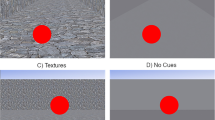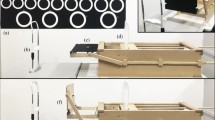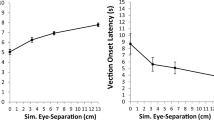Abstract
Accommodation has been suspected as a contributor to size illusions in virtual environments (VE) due to the lack of appropriate accommodative stimuli in a VE for the objects displayed. Previous experiments examining size-constancy in VE have shown that monocular cues to depth that accompany the object are a major contributor to correct size perception. When these accompanying cues are removed perceived size varied with the object’s distance from the subject, i.e., visual angle. If accommodation were the dominant mechanism contributing to a visual angle response [due to its action to keep physical objects clear] in this condition, an open-loop accommodation viewing condition might restore size-constancy to this condition. Pinhole apertures were used to open-loop accommodation and examine if size-constancy might be restored when few accompanying monocular cues to depth were present. Visual angle performance when viewing a low cue environment was found with and without the use of the pinhole apertures. Thus, these results signify that accommodation does not play a dominate role in the loss of size-constancy in sparse visual environments often used in VE. These results suggest that size-constancy is driven by the inclusion of the remaining monocular cues to depth in VE as it is in the physical world.


Similar content being viewed by others
Notes
To be more specific, when a subject looks at the VE scene projected on to the screen in front of them, the blur signal that drives accommodation is determined by the distance the subject is from the screen. Other forces may try to change this level of accommodation such as the influence of vergence but the need to maintain a clear image would cause accommodation to resist such changes and remain close to the dioptric value for the wall. In the case of VE, accommodation can be considered fixed at the projection screen and resists any vergence-accommodation influences due to the necessary convergence of the eyes to prevent diplopia. However, if we open-loop accommodation so that regardless of the level of accommodation the retinal image remains clear then changes in accommodation due to vergence may occur without a concomitant change in the blur of the physical target.
To explain further, since accommodation is open-loop when viewing the image through the pinhole aperture, accommodative demand [i.e., accommodative blur signal] over a large range of distances should be reduced due to the large depth of focus. In addition, vergence driven accommodation could be manifested with little resistance from the accommodative feedback loop used to reduce blur. Therefore vergence demands needed to fuse targets could drive accommodation essentially unencumbered. Even though it is unlikely that this resulting accommodative state would be identical to a physical world condition, the release from a fixed accommodative state using a pinhole might change size and distance judgments about virtual objects. That is, releasing accommodation from being fixed to the distance of the physical wall and allowing it to vary with vergence could produce conditions that are more in concert with other visual information and show an improvement in size setting performance.
References
Baitch, L., and R. C. Smith. Physiological correlates of spatial perceptual discordance in a virtual environment. In: Proceedings Fourth International Projection Technology Workshop, Ames, Iowa, 2000.
R. B. Bausell, Y.-F. Li Power Analysis for Experimental Research. A Practical Guide for the Biological, Medical and Social Sciences. Cambridge UK: Cambridge University Press, 2002.
W. N. Charman, J. A. Jennings Properties of annular artificial pupils. Vision Res., 19, 947–949, 1979.
C. Cruz-Neira, D. Sandin, T. Defanti, R. Kenyon, J. Hart The CAVE audio-visual environment. A.C.M. Trans. Graphics, 35, 65–72, 1992.
R. Descartes, La Dioptrique, discours VI: de la vision vol. 1. Cambridge, England: Cambridge Univ. Press, 1985, 1637.
Eggleston, R. G., W. P. Janson, and K. A. Aldrich. Virtual reality system effects on size-distance judgments in a virtual environment. In: Proceedings of VRAIS, 1996, pp. 139–146.
J. P. Frisby, D. Buckley, J. M. Horsman Integration of stereo, texture, and outline cues during pinhole viewing of real ridge-shaped objects and stereograms of ridges. Perception, 24, 181–198, 1995.
L. O. Harvey Jr., H. W. Leibowitz Effects of exposure duration, cue reduction, and temporary monocularity on size matching at short distances. J. Opt. Soc. Am., 57, 249–253, 1967.
B. E. Holaday Die Grössenkonstanz der Sehdinge bei Variation der inneren und äusseren Wahrnehmungsbedingungen. Arch. Gesch. Psychol., 88, 419–486, 1933.
A. H. Holway, E. G. Boring Determinants of Apparent Visual Size with Distance Variant. Am. J. Psychol., 54, 121–151, 1941.
R. V. Kenyon, T. A. DeFanti, D. J. Sandin Visual requirements for virtual environment generation. J. Soc. Inform. Display, 3, 211–214, 1995.
R. V. Kenyon, D. Sandin, R. Smith, R. Pawlicki, T. Defanti Size-constancy in the CAVE. Presence: Teleop. Virt. Environ. 16, 172–187, 2007.
H. W. Leibowitz, R. A. Dato Visual size-constancy as a function of distance for temporarily and permanently monocular observers. Am. J. Psychol., 79, 279–284, 1966.
H. Leibowitz, D. Moore The role of changes in accommodation and convergence in the perception of size. J. Opt. Soc. Am., 56, 1120–1123, 1966.
C. Neveu, T. Blackmon, L. Stark Evaluation of the Effects of a Head-mounted Display on Ocular Accommodation. Presence: Teleop. Virt. Environ., 7, 278–289, 1998.
Peli, E. Real vision and virtual reality. Opt. Photon. News July:28–34, 1995.
W. Robinett, J. P. Rolland A computational model for the stereoscopic optics of a head-mounted display. Presence: Teleop. Virt. Environ., 1, 45–62, 1992.
J. P. Rolland, W. Gibson, D. Ariely Towards quantifying depth and size perception in virtual environments. Presence: Teleop. Virt. Environ., 4, 24–29 1995.
J. P. Rolland, M. Krueger, A. Goon Multi-focal planes in head-mounted displays. Appl. Opt., 39, 3209–3215, 2000.
J. Wann, S. Rushton, M. Mon-Williams Natural problems in the perception of virtual environments. Vision Res., 35, 2731–2736, 1995.
P. A. Ward, W. N. Charman On the use of small artificial pupils to open-loop the accommodation system. Ophthal. Physiol. Opt., 7, 191–193, 1987.
Acknowledgments
The authors thank our subjects for their diligence and tireless interest in these experiments. We also thank Rajesh Balasubramanian, and Tim Portlock for their assistance in conducting these experiments. The authors also thank the anonymous reviewers for their insightful and constructive comments. This research was supported by General Motors Research contract #2-5-37457.
Author information
Authors and Affiliations
Corresponding author
Rights and permissions
About this article
Cite this article
Kenyon, R.V., Phenany, M., Sandin, D. et al. Accommodation and Size-Constancy of Virtual Objects. Ann Biomed Eng 36, 342–348 (2008). https://doi.org/10.1007/s10439-007-9414-7
Received:
Accepted:
Published:
Issue Date:
DOI: https://doi.org/10.1007/s10439-007-9414-7




